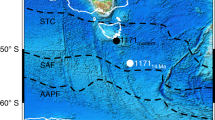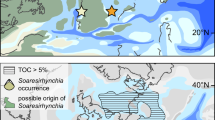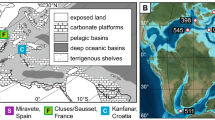Abstract
During the mid- and Late Cretaceous period, North America was split by the north–south oriented Western Interior Seaway. Its role in creating and maintaining Late Cretaceous global greenhouse conditions remains unclear. Different palaeoceanographic reconstructions portray diverse circulation patterns1,2,3. The southward extent of relatively cool, low-salinity, low-δ18O surface waters critically distinguishes among these models, but past studies of invertebrates could not independently assess water temperature and isotopic compositions. Here we present oxygen isotopes in biophosphate from coeval marine turtle and fish fossils from western Kansas, representing the east central seaway, and from the Mississippi embayment, representing the marginal Tethys Ocean. Our analyses yield precise seawater isotopic values and geographic temperature differences during the main transition from the Coniacian to the early Campanian age (87–82 Myr), and indicate that the seaway oxygen isotope value and salinity were 2‰ and 3‰ lower, respectively, than in the marginal Tethys Ocean. We infer that the influence of northern freshwater probably reached as far south as Kansas. Our revised values imply relatively large temperature differences between the Mississippi embayment and central seaway, explain the documented regional latitudinal palaeobiogeographic zonation4,5 and support models with relatively little inflow of surface waters from the Tethys Ocean to the Western Interior Seaway2,3.
This is a preview of subscription content, access via your institution
Access options
Subscribe to this journal
Receive 12 print issues and online access
$259.00 per year
only $21.58 per issue
Buy this article
- Purchase on Springer Link
- Instant access to full article PDF
Prices may be subject to local taxes which are calculated during checkout



Similar content being viewed by others
References
Slingerland, R. et al. Estuarine circulation in the Turonian Western Interior seaway of North America. Geol. Soc. Am. Bull. 7, 941–952 (1996).
Watkins, D. K. Calcareous nannofossil paleoceanography of the Cretaceous Greenhorn Sea. Geol. Soc. Am. Bull. 97, 1239–1249 (1986).
Poulsen, C. J., Barron, E. J., Johnson, C. C. & Fawcett, P. Links between major climatic factors and regional oceanic circulation in the mid-Cretaceous. Spec. Pap. Geol. Soc. Am. 332, 73–89 (1999).
Kauffman, E. in Jurassic-Cretaceous Biochronology and Paleogeography of North America (ed. Westerman, G.) 273–306 (Geol. Assoc., 1984).
Nicholls, E. & Russell, A. Paleobiogeography of the Cretaceous Western Interior Seaway of North America: The vertebrate evidence. Palaeogeogr. Palaeoclimatol. Palaeoecol. 79, 49–169 (1990).
Frakes, L. Estimating the global thermal state from Cretaceous sea surface and continental temperature data. Spec. Pap. Geol. Soc. Am. 332, 49–57 (1999).
Puceat, E. et al. Fish tooth δ18O revising Late Cretaceous meridional upper ocean water temperature gradients. Geology 35, 107–110 (2007).
Tourtelot, H. A. & Rye, R. O. Distribution of oxygen and carbon isotopes in fossils of Late Cretaceous age, Western Interior region of North America. Geol. Soc. Am. Bull. 80, 1903–1922 (1969).
Wright, E. Stratification and circulation of the Late Cretaceous Western Interior Seaway of North America. Geol. Soc. Am. Bull. 99, 480–490 (1987).
Fisher, C. & Arthur, M. Water mass characteristics in the Cenomanian U.S. Western Interior seaway as indicated by stable isotopes of calcareous organisms. Palaeogeogr. Palaeoclimatol. Palaeoecol. 188, 189–213 (2002).
Barrick, R., Fischer, A. & Showers, W. Oxygen isotopes from turtle bone: Applications for terrestrial paleoclimates. Palaios 14, 186–191 (1999).
Coulson, A., Kohn, M., Shirley, M., Joyce, W. & Barrick, R. Phosphate oxygen isotopes from marine turtle bones: Ecologic and paleoclimate applications. Palaeogeogr. Palaeoclimatol. Palaeoecol. 264, 78–84 (2008).
Hirayama, R. in Ancient Marine Reptiles (eds Callaway, J. & Nicholls, E.) 225–241 (Academic, 1997).
Kolodny, Y., Luz, B. & Navon, O. Oxygen isotope variations in phosphate of biogenic apatites, I. Fish bone apatite—rechecking the rules of the game. Earth Planet. Sci. Lett. 64, 398–404 (1983).
Puceat, E. et al. Revised phosphate-water fractionation equation reassessing paleotemperatures derived from biogenic apatite. Earth Planet. Sci. Lett. 298, 135–142 (2010).
Craig, H. & Gordon, L. in Marine Geochemistry (eds Schink, D. & Corless, J.) 277–374 (Univ. Rhode Island, 1965).
Poulsen, C. J., Barron, E. J., Peterson, W. H. & Wilson, P. A. A reinterpretation of mid-Cretaceous shallow marine temperatures through model-data comparison. Paleoceanography 14, 679–697 (1999).
Fassell, M. L. & Bralower, T. J. Warm, equable mid-Cretaceous: Stable isotope evidence. Spec. Pap. Geol. Soc. Am. 332, 121–142 (1999).
Poulsen, C. J., Pollard, D. & White, T. S. General circulation model simulation of the δ18O content of continental precipitation in the middle Cretaceous: A model-proxy comparison. Geology 35, 199–202 (2007).
McConnell, M. et al. Seasonal variability in the salinity and oxygen isotopic composition of water from the Cariaco basin, Venezuela: Implications for paleosalinity reconstructions. Geochem. Geophys. Geosyst. 10, Q06019 (2009).
Everhart, M. Oceans of Kansas. (Indiana Univ. Press, 2005).
Roche, D., Domadieu, Y., Puceat, E. & Pailard, D. Effect of change in δ18O content of the surface ocean on estimated sea surface temperatures in past warm climate. Paleoceanography 21, PA2023 (2006).
Zhou, J., Poulsen, J., Pollard, D. & White, T. Simulation of modern and middle Cretaceous marine δ18O with an ocean-atmosphere general circulation model. Paleoceanography 23, PA3223 (2008).
Roberts, E., Tapanila, L. & Mijal, B. Taphonomy and sedimentology of storm-generated continental shell beds: A case example from the Cretaceous Western Interior Basin. J. Geol. 116, 462–479 (2008).
Eberth, D., Brinkman, D. & Barkas, V. in New Perspectives on Horned Dinosaurs (eds Ryan, M., Chinnery-Allgeier, B. & Eberth, D.) 495–508 (Indiana Univ. Press, 2010).
Dettman, D. et al. Seasonal stable isotope evidence for a strong Asian monsoon throughout the past 10.7 m.y. Geology 29, 31–34 (2001).
Kohn, M., Miselis, J. & Fremd, T. Oxygen isotope evidence for progressive uplift of the Cascade Range, Oregon. Earth Planet. Sci. Lett. 204, 151–165 (2002).
Vennemann, T., Fricke, H., Blake, R., O’Neil, J. & Colman, A. Oxygen isotope analysis of phosphates: A comparison of techniques for analysis of Ag3PO4 . Chem. Geol. 185, 321–336 (2002).
Koch, P., Tuross, N. & Fogel, M. The effects of sample treatment and diagenesis on the isotopic integrity of carbonate in biogenic hydroxylapatite. J. Archaeolog. Sci. 24, 417–429 (1997).
Acknowledgements
Funding was provided by the American Chemical Society Petroleum Research Fund (PRF #43732-AC2 to M.J.K.), the National Science Foundation (ATM 0400532 and EAR0819837 to M.J.K.), the Geological Society of America, the Association of Applied Paleontological Sciences, and the Evolving Earth Foundation. Specimen access was facilitated by E. Hooks (Alabama Museum of Natural History), R. Zakrewski (Sternberg Museum), G. Phillips (Mississippi Museum of Natural Science), J. Ebersol (McWayne Center), M. Carrano and R. Purdy (United States National Museum), I. Rutzky and J. Maisey (American Museum of Natural History), M. Triebold and A. Maltese (Rocky Mountain Dinosaur Resource Center), and G. Rockers.
Author information
Authors and Affiliations
Contributions
A.B.C. performed analyses, processed data and prepared the manuscript. M.J.K. and R.E.B. provided funding and facilities, oversaw the research and assisted in manuscript preparation.
Corresponding author
Ethics declarations
Competing interests
The authors declare no competing financial interests.
Supplementary information
Supplementary Information
Supplementary Information (PDF 680 kb)
Rights and permissions
About this article
Cite this article
Coulson, A., Kohn, M. & Barrick, R. Isotopic evaluation of ocean circulation in the Late Cretaceous North American seaway. Nature Geosci 4, 852–855 (2011). https://doi.org/10.1038/ngeo1312
Received:
Accepted:
Published:
Issue Date:
DOI: https://doi.org/10.1038/ngeo1312



